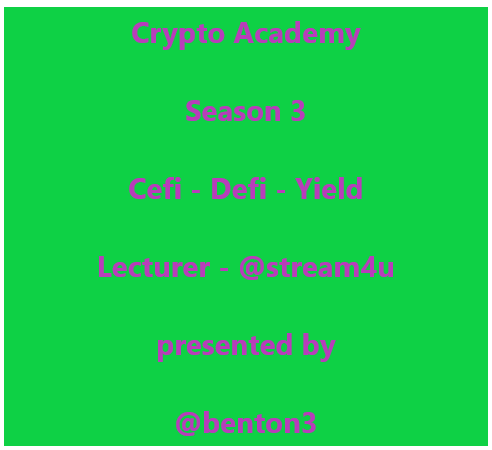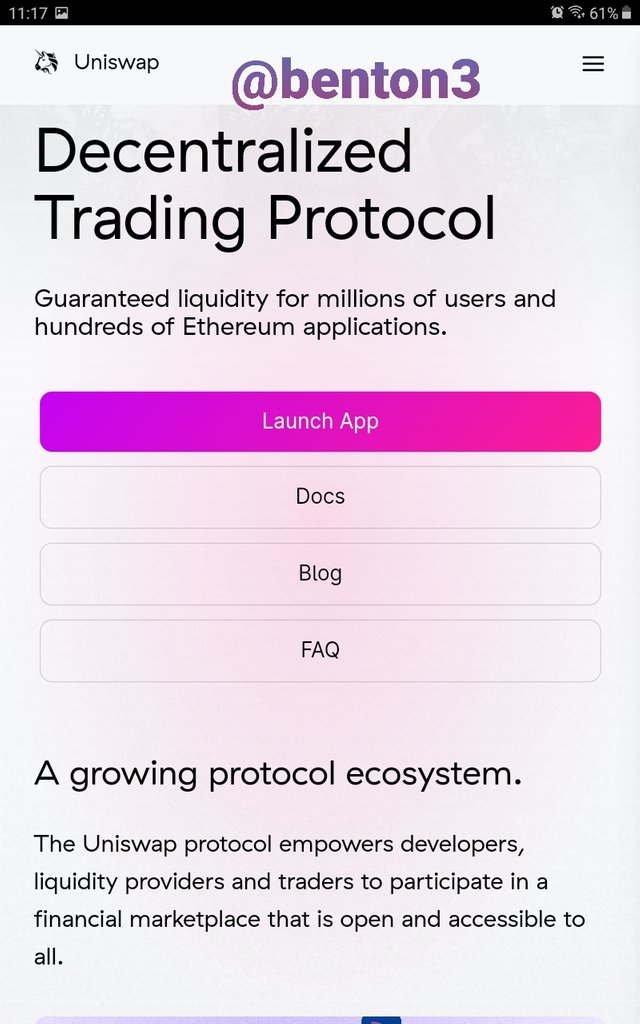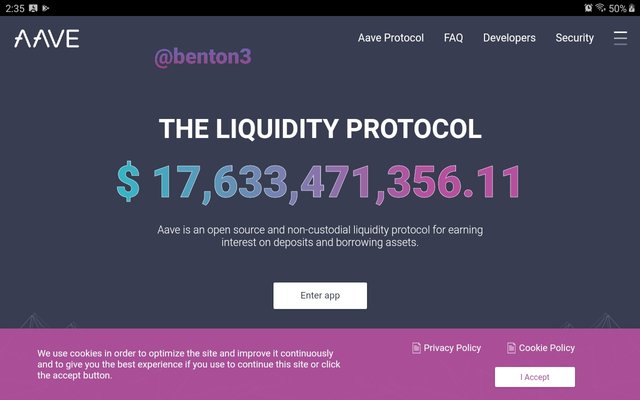Crypto Academy / Season 3 / Week 4 - Homework Post for [@stream4u] … by @benton3

Hello my good friends, i hope we are all doing well. I am over here. It is great to participate in crypto academy week 4 of season 3. This time, I will be writing on the homework task of @stream4u on the subject CeFi - DeFi - Yield
Introduction
DeFi fully known as decentralized finance can be defined as the various financial applications or protocols seen in cryptocurrencies and blockchains which aims at stoping or reducing the use of financial intermediaries known as third parties in financial transactions.
In DeFi, assets, Smart contracts and Dapps are run on it making it an all inclusive financial system. This removes the bottlenecks attached to the traditional way of conducting financial transaction, where the sender and the receiver are entirely dependent on the intermediary to ensure a successful transaction.
In DeFi, financial transactions are carried out automatically with the use of blockchain technology.

1. What Is the Importance Of the DeFi System?
The importance of DeFi are enormous. We are going to explain them below.
● With the use DeFi in financial trasactions the users do not need to know themselves in other to do so. Both lenders and borrowers are anonymous
● The individual is in full control of his funds. An investor have full control of his assets without entrusting it to a third party or intermediary. This creates the opportunity for the investor to invest in various projects and earn multiple returns.
● DeFi offers its users much higher returns than the traditional institutions like banks. Sometimes too, in addtion to earning much higher interest, the investor earns some tokens too.
● There are so many unbanked individuals in the world, but most people have android phones. Thus Defi enables them access to the world of finance without stress.
● Due to the use of DeFi, cost of transactions are very low and minimal, since there is no third party to be paid for this services.
● It facilitates the process of lending and borrowing within the financial world and makes it very easy. Such could be done from the comfort of your home.
● DeFi applications can always be adjusted to meet the needs of its users.
● There is no central power or authority, as such each one is independent and can take his or her decisions.

2. Flaws in Centralized Finance.
Centralized finance is just the opposite of DeFi. It is the traditional way of consummating financial trasaction, where the process is centralized. It is centralized in the sense that the both parties involved in a transaction, must pass through an intermediary. There is a one central power that determines what and how it should be done, as well as the value of currencies in circulation.
All the orders, information and directions comes from a central source. It is an entirely monopolistic system.
The flaws inherent in a centralized system are as follows
◇ There is a central system of authority and control, which does not give participants in the market freedom to operate.
◇ In centralized finance, there is delay in transaction processing, sometimes, it takess about more than a week for a transfer to be completed.
◇ Transaction fees are high since the intermediary needs to be paid for his services.
◇ Returns on investment for centralized system of finance is low compared to a decentralized system.
◇ Fund owners does not have access to their assets and are not in control of it.
◇ it makes the players in a centralised system to perform their task like robots bereft of any initiatives, as if they were remote controlled.
◇ This system only enriches those at the central authority.
◇ Whenever there is a problem with the central body, the depositors or investors are adversely affected too. Since they stand a chance of loosing there funds as well.

3. DeFi Products. (Explain any 2 Products in detail).
The two DeFi products that I will be explaining are
Decentralized Exchanges
Lending
Decentralized Exchanges
Decentralized exchanges is product of decentralized finance. This gives people, in this case traders, lenders, borrowers, the opportunity to buy or sell, lend their assets, borrow as well and swap to any coin of their choice without the need for an intermediary during the course of the transaction.
Thus, third parties are entirely eradicated when a transaction is conducted through a decentralized exchange.
One of the examples of this is Uniswap.
This is a decentralized trading protocol, which runs on the ethereum blockchain, and regarded as one of the best DeFi projects around.
It was founded by Harden Adams on November 2, 2018, and facilitates crypto currency transactions by the use of smart contracts.
It applies the use of a protocol known as automated liquidity protocol, which gives users complete control of their assets. It has a native token called UNI. The rise in price of its native token testifies to the operationability and functionality of the system.
The system is made in such a way that the holders of the native token reserves the right to vote and suggest developmental ideas for the governance and sustanability of the platform.
Since the protocol was built in etherium blockchain, it allows the swapping of erc20 token whether there be demand for it or not. It is not reliant on buyers and sellers to create needed liquidity. Uniswap uses the quantity of Ethereum and other erc20 tokens available in the liquidity pool to provide liquidity and determine the price of a token.
It uses the formula a*b = k
Where a = available Ethereum in the pool represented in $
Y = quantity of other tokens in the pool represented in $
k = is a constant value represented in $
Let us say, a buyer buys freecoin token, the supply of freecoindecreases while that of ethereum increase. This automatically leads to the increase in the price of freecoin. This in essence balances out the value of the tokens irrespective of the people swapping. No wonder K = is constant in value
Uniswap also pays its pool providers a fee of 3%. Uniswap coins are created whenever Ethereum or any other erc20 token is contributed to the liquidity pool. This token is given to the pool provider as a kind of certificate, identifying him as a pool provider.
An advantage of this token is that it can be moved, swapped and used in other Dapps. Once a provider reclaims his Ethereum or erc20 token, the uniswap token is burned. Thus possession of the uniswap token is an evidence of your share in the pool and the pools trading fees.
Uniswap have so many other features that makes it very desirable. It presently supports USDT which was formerly incompatible with the uniswap system. It allows its trader to determine their risk level thus lower fees are charged especially on volatile token.
So we can say that Uniswap is one of the leading Defi projects considering the total value locked up, which is a way to value the crypto assets in the platform.
Lending
This is another product of DeFi, where the investors can lend their assets to the lending pool and earn interest by doing so. Others that needs liquidity can also borrow from the pool with a rate as interet to be paid.
An example of this is the Aave
This is another DeFi project built on the ethereum blockchain. Aave is a lending platform using smarts contract. It allows some erc20 coins to be used on its platform including USDC and DAI. Apart from being a long term loan project, it also introduced a short term loan project known as flash loans. This is the first type of loan with no collateral ever had on a DeFi project.
It was founded by Stani Kulechov, whose intent is to develop a blockchain like twitter. He believes that when this is done, twitter users can monetise their post.
It is a decentralized platofrm which also allows users to earn interest too on their deposits. It can allow any person to communicate with it through APIs, or any third party application.
The native token for this Defi is also (Aave). When an investor deposits his assets into the liquidity pool, he is given Aave token,. This token can be swapped or traded just like any other erc20 token. When a depositor wants to liquidate his position in the pool, he brings back his Aave token while he gets his liquidity back.
Just like the Uni token, holders of Aave participates in the voting to determine and decide on any adjustment or improvements to be made on the platform. Another good thing about this platform, is that it token can still be staked to earn more staking rewards.
Currently there are over $17b in the liquidity protocol of Aaves and it is growing day by day. Such value locked in this protocol, shows the confidence borrowers and lenders have on the system.

4. Risk involved in DeFi.
Just like any other venture, DeFi have its own demerits and risks. Some of the risks associated with DeFi are
■ Price Volatility- when there is a serious drop in prices of an asset, let us say Ethereum, it can lead to forced liquidation, which will in turn lead to more selling pressure on Ethereum, push the price further downwards.
■ Every project is not 100% secured. Thus when a Defi project ia maliciously attacked, the smart contracts are infiltrated. This keeps investors locked funds at risk of being drained or hacked. This is even made more easier, since the project is open to public assessment.
■ Rug Pulls - this can be defined as the devise used by people to make quick money. We need to understand that anyone can create a token and enlist it in any defi project. Invariably a liquidity pool will be created for the token. Unsuspecting investors will now be encouraged via social media to buy into the token using valuable tokens.
Once they noticed they have gotten much of these valuable token, they remove their liquidity from the Defi exchange, leaving the investor with a worthless coin(shit).
These ones are fraudsters, they can really rundown an exchange, if investors know the exchange is fond of accepting anyhow businesses in the exchange.
■ There is the risk of impermanent loss. This occurs when the price at which an investor provided liquidity at the pool drops drastically, due to volatility in price.
■ High Fee Charges - So many defi protocols run on ethereum blockchain. And we all know the high gas fees taken for any ethereum based transaction. This is due to lack of scalability of the ethereum blockchain. It is very slow in processing. Thus if ever Defi is to be universally acceptable. The issus of scalability needs to be resolved.
■ DeFi's stand the risk of been banned by the regulatory authorities. They already have a regulatory framework of control for the centralized system, thus, been unable to regulate the decentralized system may lead them to ban its operation.
■ Identity problems can also cause the government to clampdown on it. Since users do not need to identify themselves or verify whom they are before engaging in any transaction.
■ Loss of Private Keys - one of the benefit of a decentralized system is that a user have control over his fund. But that poses another problem in terms losing ones private key. If the user does not keep the keys well and it gets lost, that simply means his assets are lost eternally.
■ Risk associated to smart contracts - We need to remember that charges are taken even when the transaction did not go through. Those charges are non-refundable. Over the course of time, its accumulation can result in substantial loss to the DeFi user.

5. What is Yield Farming?
Yield farming is a process where crypto owners and holders earn rewards for holding them. The owners, a kind of lend their token to the liquidity pool and earns interest from the trading fees. Like I earlier mentioned in the case of Aave, holders can still earn interest, just by holding the governance token.
We can look at as a way of using the crypto assets we have to get more crypto asset. So instead of an asset holder to keep an asset especially during this bearish market, he can make more money by farming, earning more crypto asset in return.
This also increases his holdings on other assets. In farming, the coin used are mostly stable coins, even though some protocols still allows other tokens like BNB in Binance and ETHER in Ethereum based DeFi.
For a farming to successfully take place, there must be a liquidity pool and the provider
Yield farming has helped several projects to get the necessary liquidity and very useful for lenders and borrowers. Another benefit of yield farming is that it provides more attractive rates for investors than the traditional financial system.

6. How does Yield Farming Work?
For yield farming to work, it involves two parties or activities; Liquidity providers and liquidity pool
a. Liquidity providers- These are those who deposit funds or crypto assets to the pool.
b. Liquidity pool - this is where the lent assets are kept for the borrowers to borrow or exchange from.
Ordinarily, using this platform takes some fees or charges. It is this charges that are paid as earnings to the providers of liquidity. Other incentives for farming can also be to earn new crypto assets in the market.
Like some weeks ago, Binance had a farming protocol where you deposit BNB and earn Klay token. It could not be bought from any market, thus it created an avenue of distribution for the Klay token, providing liquidity for it.
The earnings received by the liquidity providers is proportional to the amount of liquidity they provided to the pool.
The tokens most at times supplied or requested as liquidity are stable coins, some platforms accept ethereum or any other erc20 tokens. Binance mostly use BUSD which is a stable coin and BNB token too. Tron blockchain accepts tron tokens.

7. What Are the best Yield Farming Platforms and why they are best. (Explain any 2 in detail)
Pancakeswap
One of the known yielding plaforms is the Pancakeswap platform. This platform makes use of the Automated Market market and is run on Binance Smart Chain. This allows two tokens to be used on Binance Smart Chain. It has it own native token called CAKE.
The platform is fast, cheap and allows anybody to participate. Currently, it has a TVL of over $6B and an adjusted TVL of $20.84b. It also has 16 smart contracts running also.
Investors can earn cake tokens, PMON, TRX and Chess, when they farm in this dapp. The good thing about this platform, is that you can also earn on the CAKE token earned as a reward for adding to the liquidity pool.
Because this platform is run on BSC platforms, the charges are less, thereby enabling so many borrowers and project owners to run and use the platform.
Yearn.finance
This is another yield farming protocol that seeks to make the most out of lending, by finding out the most profitable lending services. Funds deposited are converted to ytoken and now used for lending.
This platform is very good for new farmers or those who do not have the time to select the best lending or farming plaform. So the system automatically does that for them, choosing the best strategies for them.
This protocol wants to be a link to the various yield generating products within the ethereum ecosystem.

8. The Calculation method in Yield Farming Returns.
When it comes to returns in yield farming, it can be in two ways
- Annual percentage yield(APY)
- Annual percentage rate(APR)
Annual Percentage Yield
This is the interest rate paid to investors for locking up their asset in the pool. In this rate calculation, accumulated interest are reinvested and used to earn higher returns. This return is based on compound interest calculation
To explain further, the interest earned on the first day is reinvested or added to the capital locked and is then used as the basis for interest calculation the next day.
The formular for APY IS
** APY =100[(1+r/n)n. -1]**
r = rate of return
n = number of compounding times or periods
Assuming the APY of a particular pool is 40%, and the investment will be locked up for one year, principal invested is $100, then the interest is calculated as follows
APY = 100 [(1+0.4/365)365 - 1]
= 100 [ (1+0.0011)365 - 1]
= 100 [ (1.0011*365) - 1]
= 100 [ 1.494- 1]
= 100 [ 0.494]
APY = 49.4
This means that the investor would be earning an additional $ 49.4 for his investment. So the total amount he will be going home with is $100 + $49.4 = $149.4
Annual Percentage Rate( APR)
The Annual percentage rate is just a simple interest calculation of the earning. Only the amount invested is used. The interest is not reinvested in this case.
So if the investor capital is $100, and the rate is still $40 and time period is 365 days. This means that in one year, he will have an additional $40 as his earnings on investment.
At the end of the investment period, he will be going home with $140.
So we can see from the foregoing, that the APY gives a better returns than the APR.
It is also good to note however, some factors can also affect the returns if not the loss of funds, like hacking, drop in assets prices which could lead to liquidation, etc.

9. Advantages & Disadvantages Of Yield Farming.
Advantages
♡ it offers higher profits compared to traditional financial investment systems because of the use of compound interest profit formula.
♡ It provides an avenue for new project to access liquidity in the market to kick start their projects
♡ it assist to cut down losses during a bearish market
♡ It is a means of having multiple crypto assets through earnings without spending to acquire them
♡ Rewards from yield from other farming can be reinvested in other projects, leading to multiple profit opportunities.
Disadvantages
Despite the huge benefits derived from yield farming, there are some disadvantages associated with it. These disadvantages are stated below.
♤ Smart Contract risk.
Just like any system code, the smart contract risk being bugged. Hackers can drain the funds in the system, causing investors to lose their funds and may even lead to the end of the project.
♡ Impermanent loss
Due to sharp drop in market prices, investors can suffer imperment loss. The assets are locked in the pool, such that cannot sell it when noticed that price is falling. That is why so many farming protocol uses stable coins to mitigate the risk.
♡ Asset Liquidation
The userd stands the risk of losing their investments due to high volatility in the market. Let us remember that the collateral provided is always above the value of the of the loan. So if the price drops below the loan value, it is liquidated at a lower price, causer the loaner to bear some losses.
♤ Fraudulent projects
So many can be run on the blockchain due to its decentralized nature. Hence, fraudsters can launch there own projects using it to swindle people of their of their hard earned money. They normally give the users worthless token as a replacement which amounts to nothing. Every investor should do his evaluation on projects before investing.

10. Conclusion on DeFi & Yield Farming.
I would love to say that I have learnt so many things from this assignment. DeFi has come to stay, improving on almost the demerits experienced in centralized finance system. It has made investment to be of little stress, bringing financial trasactions to the unbanked population..
It has created several opportunities for people to earn extra income from. I have been also learned about various defi protocol and how it works.
Yield farming is a way of acquiring additional cryptos without really paying for it. Thus I can even use this to secure the value of my asset, when there is bearish market, against dips in price.
Though these forms of investment are good, I need to do thorough research on any project I want to invest in so that, I will not fall prey to scammer and fraudsters.
Thank you @stream4u for this amazing lecture.




Hi @benton3
Thank you for joining The Steemit Crypto Academy Courses and participated in the Homework Task.
Your Homework Task verification has been done by @Stream4u, hope you have enjoyed and learned something new.
Thank You.
@stream4u
Crypto Professors : Steemit Crypto Academy
#affable
Thank you professor, i truly appreciate your honest assessment.
Thanks u @benton3 for this vital information, even if I don't really understand much about crypto, but after going through this post of UR I , I now believe that a have nothing to worry about crypto academy
Thanks sis for going thru my post. Hope you can join us too. There are so many things to learn .